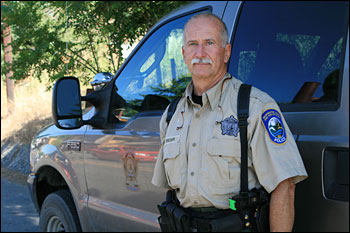home | internet service | web design | business directory | bulletin board | advertise | events calendar | contact | weather | cams

|
The Hunts Begin
Don’t wear green, black, dark blue or brown, says Cal Treser, enforcement officer for the Washington State Department of Fish and Wildlife. "Be seen. Wear bright colors like red, yellow or hunter orange." Bear season doesn’t draw huge numbers of hunters, says Treser, but it does last until Nov. 15. Non-hunters wandering in the woods won’t be alerted to the presence of bear hunters by baying hounds, since it’s been illegal to use hounds to hunt bears, cougars or other wildlife since 1996. "There is no hound hunting for anything," says Treser. Bear baiting is illegal, too, adds Treser, but some people still do it. He says the bait sites are hard to find and require many hours of surveillance to apprehend the violators. "They’re hidden," he says of the baiting sites. "And you never know when they’re coming back," he says of the baiters. Treser, 62, single-handedly patrols nearly 2,000 square miles. Centered in the Methow Valley, his jurisdiction reaches from the Pasayten Wilderness south to Pateros and westward to the ridges above Lake Chelan. Only during deer season does he get a little extra help. He’s had the job since 1999. He’s the guy you call - at 509-322-4356 – to report suspicious hunting activity or to put down a deer hit by a car. If he’s not available and the animal is so badly injured that it needs to be shot, just do it, he says. "I don’t want animals to suffer." But remember to call him and/or the local police or marshal to report what you’ve done and where the carcass can be found.
What’s the toughest part of his job? "The biggest challenge is managing people," says Treser, who has been a game warden for 32 years. "The vast majority of hunters are very respectful" of the law, Treser says. But there are always those few who aren’t. What’s the scariest thing he’s experienced? "Vietnam," is his immediate answer, alluding to his combat experience. In his present job, he says, "I have people who threaten to kill me all the time," though there’s never been a violent incident. "They just go to jail," he adds matter-of-factly; threatening an officer of the law is a criminal offense. Treser says he used to see more illegal hunting activity, such as poaching, hunting from the roadway and trespassing, than he sees now. "I do concentrate on these issues," he adds. "I spend a lot of hours working at night," he explains, chasing night poachers, who use spot lighting to illegally shoot game animals. Poaching and other illegal hunting is unacceptable because "There needs to be a level playing field for everyone," he says. Treser is also is the man to call when conflicts arise between humans and the "migratory" local mule deer herd, such as browsing damage on private property and aggressive does that charge humans and dogs when their fawns are young. Because aggressive does pose a public safety problem, "Those deer need to be eliminated," Treser says. Alluding to well-meaning but misinformed people who feed deer that eventually become a public nuisance requiring his lethal attention, he says: "They create the problem, then they want us to solve the problem." Deer habituated to feeding will hang around and not migrate. When snow comes, they’re trapped and can’t migrate down to the Columbia River where they belong in winter, he says. Feeding deer "keeps them here when they shouldn’t be here," he stresses. Deer will leave to seek food elsewhere if they’re not fed, he adds. Does this mean hungry deer should be left to die? "I think so," answers Treser. He’s not the man to call to report deer feeding inside Twisp or Winthrop city limits, where it’s outlawed. The local police or marshal’s office handles those calls. "There is no (state) law on feeding deer," he says, so his only tools to stop deer feeding are education and persuasion. He says feeding harms the animals because it congregates them, thus making it easier for sick ones to spread parasites and diseases to the whole herd, and it makes them easier prey for predators. The other problem with deer feeding is that the animals usually are given food they’re not designed to digest, such as alfalfa or hay, according to Treser. When emergencies arise and the wildlife department itself resorts to deer feeding, the animals are fed specially formulated pellets that are ordered in advance, he says. It takes several weeks for the bacteria to develop in the deer gut to make alfalfa or hay digestible, he explains. Though deer can be seen eating hay in the fields in summer, it’s important to understand that at this time of year they’re also mixing in twigs and other natural food, which enables their guts to cope with the relatively small amounts of hay and alfalfa they consume, Treser says. But when they’re fed alfalfa or hay in winter, they’re not getting their natural food to mix with it, and their digestive systems eventually fail. So even though they’re being fed, the deer are still starving, says Treser. "They die with a full belly." 8/16/11 |
 The fall hunting season got underway August 13 when the bear seasoned opened. So it’s time for hikers, bikers and other recreationists in the woods to pay attention – and put on bright clothes.
The fall hunting season got underway August 13 when the bear seasoned opened. So it’s time for hikers, bikers and other recreationists in the woods to pay attention – and put on bright clothes.